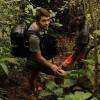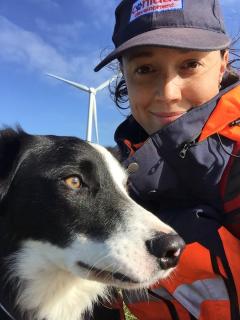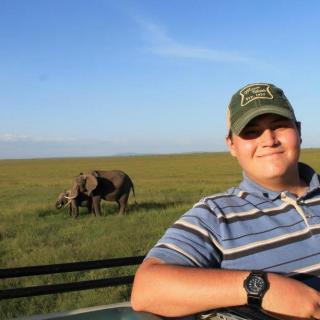Environmental DNA, or eDNA, is a molecular sampling technology that collects information about organisms using DNA shed by them into their environment. While eDNA holds exciting potential to become an efficient, low-cost, non-invasive ecological monitoring method, a lack of standardization of approaches and purpose-built sampling equipment make it hard to compare results and determine its actual effectiveness across studies. Detection success and accuracy also vary greatly among species and environments, making standardization a challenge.
However, as eDNA moves toward becoming an industry standard method for species detection and management, the equipment is beginning to transition from largely do-it-yourself experimental contraptions to professionally engineered tools. For example, Smith-Root Inc. recently developed the first-ever purpose-built eDNA sampling system, which they call ANDe™. We’re also seeing an expansion of eDNA applications from mainly marine to freshwater and even terrestrial environments, although the latter still requires substantial growth.
As this nascent field develops, it is critical for the conservation tech community to explore and identify how eDNA applies to management needs, and to ensure that continued development meets those needs. Beyond indicating species presence, research so far suggests that eDNA can contribute to conservation by deepening understanding of population dynamics, resource usage, disease presence, invasion pathways of non-native species, and population genetics, to name a few. This indicates that it could be a critical tool for managing imperiled and invasive species.
If you're new to eDNA and genomics, check out our Tech Tutors episode "How Do I Use Portable Genomics in the Field?" featuring Ineke Knot. You'll also find a bank of resources on that page, including a handy glossary of terms in our collaborative notes document!
Does your work involve eDNA and genomics, or are you curious about incorporating this type of technology into your field or lab work? Start a discussion in our group forum!
Header Image: Benjamin Barca
Universidad San Francisco de Quito
Biologist/Professor focusing on carnivore conservation in Ecuador
- 0 Resources
- 0 Discussions
- 12 Groups
San Diego Zoo Wildlife Alliance
- 0 Resources
- 3 Discussions
- 2 Groups
- @Prabisha
- | she/her
Dedicated research scientist with over 8 years of experience in cartography, spatial analysis, and statistical modeling to tackle environmental, public health, and socio-economic challenges. Passionate about leveraging geospatial technology to drive impactful solutions.
- 0 Resources
- 0 Discussions
- 12 Groups
- @Ziggy
- | She/Her
Aquatic biologist focused on aquatic invasive species and freshwater pearly mussels
- 0 Resources
- 0 Discussions
- 4 Groups
Zoological Society London (ZSL)
I am a benthic ecologist using low-cost tech to explore seabed habitats in temperate and cold water.

- 1 Resources
- 10 Discussions
- 4 Groups
- @Pema
- | He/Him/His
Naturalist/Wildlife Biologist
- 0 Resources
- 0 Discussions
- 1 Groups
- @Alawa
- | She/Her
Passionate wildlife and biodiversity conservationist
- 0 Resources
- 0 Discussions
- 24 Groups
- @mattaudette
- | he, him, his
Software Tester and Test Automator at Wildlife Protection Solutions
- 0 Resources
- 1 Discussions
- 24 Groups
- @williams
- | He/Him
I am a conservationist specializing in endangered species, particularly vultures. As the Endangered Species Conservation Coordinator/Co-Founder at Biota Conservation Hub Foundation (BiotaCHF), I have conducted extensive research/conservation of vultures and other water birds.
- 0 Resources
- 0 Discussions
- 14 Groups
- @tmcgrath
- | He / Him
Geographer, Program Manager, Engineering Manager
- 0 Resources
- 1 Discussions
- 11 Groups
World Wide Fund for Nature/ World Wildlife Fund (WWF)

- 0 Resources
- 12 Discussions
- 15 Groups
- @jodirowley
- | she/her
Conservation biologist obsessed with frogs
- 1 Resources
- 0 Discussions
- 5 Groups
Conservation International is proud to announce the launch of the Nature Tech for Biodiversity Sector Map, developed in partnership with the Nature Tech Collective!
1 April 2025
WWF's Arctic Community Wildlife Grants program supports conservation, stewardship, and research initiatives that focus on coastal Arctic ecology, community sustainability, and priority Arctic wildlife, including polar...
7 March 2025
Osa Conservation is launching our inaugural cohort of the ‘Susan Wojcicki Research Fellowship’ for 2025, worth up to $15,000 per awardee (award value dependent on project length and number of awards given each year)....
10 February 2025
The authors used the Continuous Degradation Detection and LandTrendr to map forest disturbance and regeneration, carbon sequestration and changes in habitats. This was coupled with eDNA from soil samples from...
2 November 2024
Join us in celebrating this year’s Judging Panele Award winners!
19 August 2024
Join us in celebrating this year’s Community Choice Award winners!
15 August 2024
Vote for your favorite submissions that best demonstrate conservation impact, novel innovation/discovery, and strong storytelling of the work and the sector.
12 August 2024
WildLabs will soon launch a 'Funding and Finance' group. What would be your wish list for such a group? Would you be interested in co-managing or otherwise helping out?
5 June 2024
Now accepting applications for two $15,000 grants to help protect wildlife through cutting-edge, technology-driven efforts
3 June 2024
Do you have photos and videos of your conservation tech work? We want to include them in a conservation technology showcase video
17 May 2024
Article
Read in detail about how to use The Inventory, our new living directory of conservation technology tools, organisations, and R&D projects.
1 May 2024
November 2023
event
event
6 Products
Recently updated products
| Description | Activity | Replies | Groups | Updated |
|---|---|---|---|---|
| Hi @skirchgeorg , thanks for the additional info. We discuss again about this with my colleague and we were still hesitating with the drone, as it will still make some noise that... |
|
Drones, eDNA & Genomics | 1 month 3 weeks ago | |
| Hi Nabil,What medium do you want to sample for your eDNA (soil/air/water)? If its soil then you can simply collect a sample in a bag and freeze.This is a nice soil collection... |
|
eDNA & Genomics | 3 months ago | |
| Hi all, I am trying to find simple pre-assembled eDNA sampling kits like these below but for sale in North America. Is that... |
|
eDNA & Genomics | 3 months 1 week ago | |
| Hi Simon,We (Reneco International Wildlife Consultants) have an ongoing collaboration with a local University (Abu Dhabi, UAE) for developing AI tools (cameratrap/drone... |
|
Acoustics, AI for Conservation, Animal Movement, Camera Traps, Citizen Science, Connectivity, Drones, Early Career, eDNA & Genomics, Marine Conservation, Protected Area Management Tools, Sensors | 4 months 1 week ago | |
| Hi Muhammed,If you want any help with ONT please contact me |
|
eDNA & Genomics | 4 months 2 weeks ago | |
| Hi Phil, Thanks for sharing - this is really interesting work! Seems like a cool integration of ground-based (or ocean-based) data and satellite data, with a community... |
|
Geospatial, Acoustics, Camera Traps, eDNA & Genomics | 7 months 4 weeks ago | |
| Thank you so much! Now everything is in the hands of amazing organizations and companies! But the first results of the Disaster Management cohort are bringing a very optimistic... |
|
AI for Conservation, Climate Change, Early Career, East Africa Community, eDNA & Genomics, Emerging Tech, Ending Wildlife Trafficking Online, Human-Wildlife Conflict, Open Source Solutions | 9 months 3 weeks ago | |
| Hello everyone, I'm interested in gathering insights on how the behavior of different species impacts the development and efficacy of... |
|
Animal Movement, Acoustics, Camera Traps, eDNA & Genomics, Emerging Tech, Marine Conservation | 1 year 2 months ago | |
| Hi everyone. I'm still confused about this. Is it feasible to employ environmental DNA (eDNA) for the detection of two distinct communities... |
|
eDNA & Genomics | 1 year 2 months ago | |
| Thanks Aude, very useful. Will reach out to them! |
|
Early Career, Acoustics, eDNA & Genomics, Marine Conservation, Protected Area Management Tools | 1 year 4 months ago | |
| Carly, that would be great! Thanks! I work with soundscapes and love the work of Rainforest Connection! I'll send you an email (@CUNY) to coordinate! |
|
Acoustics, AI for Conservation, Conservation Tech Training and Education, Drones, eDNA & Genomics, Emerging Tech, Geospatial | 1 year 11 months ago | |
| Thanks so much!! |
|
Acoustics, AI for Conservation, Animal Movement, Camera Traps, Community Base, Data management and processing tools, Drones, eDNA & Genomics, Emerging Tech, Open Source Solutions, Geospatial, Software Development | 2 years 7 months ago |
Webinar: Non-invasive Conservation Genetics
 Imogene Cancellare
Imogene Cancellare
13 May 2020 12:00am
Virtual Meetup Discussion: eDNA
5 December 2019 12:03pm
12 December 2019 8:35pm
Thanks!
I know there was some discussion of bioacoustics--I'll echo this interest. I have no experience and will be deploying audiomoths in my study area in early spring, so I need to get up to speed quickly!
Alex
12 December 2019 8:41pm
Ah! Well you're in luck.. We're doing acoustics first thing next year. Late January some time, so in good time for your field season. We also had the audiomoth team give a talk at one of our previous meetups - Peter Prince's talk is here.
Steph
WILDLABS Virtual Meetup Recording: Environmental DNA (eDNA)
22 October 2019 12:00am
Technology companies, FCO, and conservation NGOs come together to scale technology solutions to end wildlife crime
4 June 2019 12:00am
WILDLABS TECH HUB Showcase
17 May 2019 12:00am
Meet the WILDLABS TECH HUB Winners
13 May 2019 12:00am
Processing blood? Centrifuge troubleshooting
26 February 2018 11:47pm
6 March 2018 10:07am
Do you want me to put you in touch with folks at my company who know the second hand lab supplies market extremely well and might be able to help you buy the right centrifuge second hand?
13 March 2018 7:09pm
@ffyngau out of interest, what are you using the centrifuge for? Avian health research in Denali NP? @mattypie thanks so much for your offer to help connect with an affordable supplier.
29 March 2018 11:25am
Hi Emily,
Rachel has some practical suggestions about rigging your current centrifuge up to fit the small tubes. What do you think - vIable?
1) If you're measuring hematocrit, perhaps using flat-bottomed vials which do fit (less accurate though)
2) taping capillary tube in the tubes that fit (flat against bottom for clay retention)
3) try taping two support rods across the top to hold opposing capillary tubes
— Rachel Skubel (@rachelskubel) March 29, 2018
Steph
Technology Empowered Conservation Lecture Series
18 January 2018 12:00am
FIT Cheetahs
4 December 2017 12:00am
Learning To Be A Detection Dog Handler: The Teachings of Rubble
3 November 2017 12:00am
Plant DNA sequencing
Wildlife Crime Tech Challenge: YIARI is helping protect slow lorises
23 June 2017 12:00am
#Tech4Wildlife Photo Challenge: Our favourites from 2016
1 March 2017 12:00am
Conservation Leadership Programme 2017 Award
21 November 2016 12:00am
CSI for the Sea: How Scientists Use DNA to Spy on Whales and Find 'Extinct' Fish
18 November 2016 12:00am
5 Smart Technologies That Will Crack Down On Wildlife Trafficking
14 November 2016 12:00am
Neotropical Migratory Bird Conservation Act grants via USFWS
8 November 2016 12:00am
DNA in scent marks
28 January 2016 5:03pm
How you are you using eDNA?
Upcoming Conferences
25 January 2016 4:57pm
25 January 2016 5:01pm
There will be an eDNA talk at the Mares Conference, February 1st to 5th 2016, Olhão, Portugal
The talk is titled: "Species detections in environmental DNA using metabarcoding: a useful tool in estuaries monitoring."
Wildlife Crime Tech Challenge: Winners Announced!
22 January 2016 12:00am
Claude Miaud's eDNA presentation at 2015 Fuller Symposium
7 December 2015 3:12pm
15 December 2015 4:47pm
Thanks for sharing this, Sarah.
7 January 2016 11:09am
Article about Claude Miaud's presentation at the Fuller Symposium:
https://www.wildlabs.net/resources/thought-pieces/biodiversity-drop-water-new-opportunity-edna
Biodiversity in a Drop of Water: The New Opportunity of eDNA
24 December 2015 12:00am
Deep Coral Reef Exploration and Discovery: Two-way Technological Flow
24 December 2015 12:00am
eDNA sampling to detect invasive snails in shipping ballast water
15 December 2015 5:04pm
16 December 2015 12:05am
Thank you for sharing!
eDNA news blog
7 December 2015 4:26pm
Extensive eDNA review
7 December 2015 3:42pm
What is eDNA?
2 November 2015 12:00am


















































12 December 2019 8:23pm
Hey Alex,
Our pleasure! Yep, we will be uploading the recording along with our notes from the session to this page. We'll also upload the individual talks to our yourtube channel here. We'll have them up in the next few days, probably early next week.
We're starting to think through topics for next season - I'm interested to hear if there are any technologies/tools or questions you'd like us to cover?
Steph